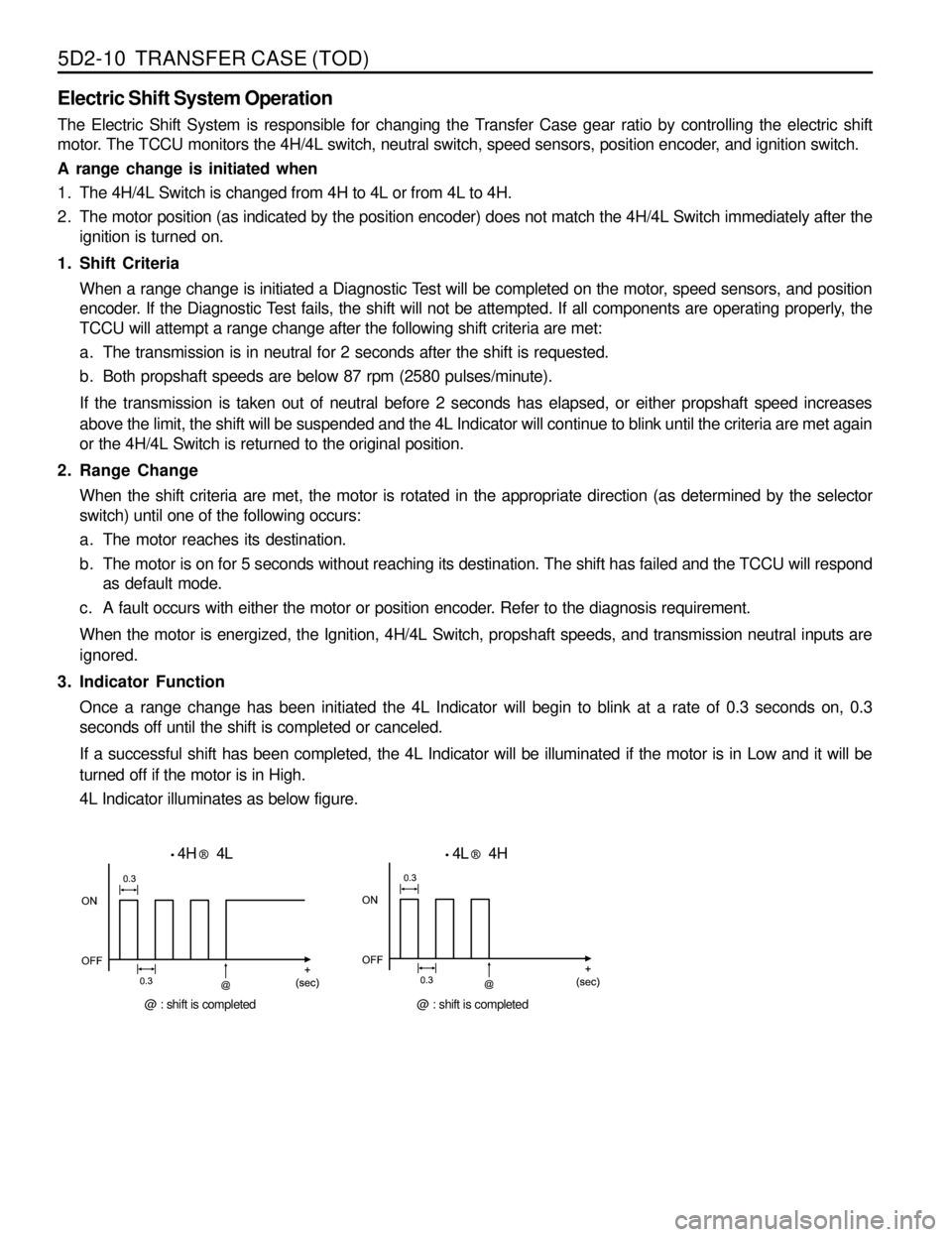1998 SSANGYONG MUSSO ESP
[x] Cancel search: ESPPage 1217 of 1463

5D2-10 TRANSFER CASE (TOD)
Electric Shift System Operation
The Electric Shift System is responsible for changing the Transfer Case gear ratio by controlling the electric shift
motor. The TCCU monitors the 4H/4L switch, neutral switch, speed sensors, position encoder, and ignition switch.
A range change is initiated when
1. The 4H/4L Switch is changed from 4H to 4L or from 4L to 4H.
2. The motor position (as indicated by the position encoder) does not match the 4H/4L Switch immediately after the
ignition is turned on.
1. Shift Criteria
When a range change is initiated a Diagnostic Test will be completed on the motor, speed sensors, and position
encoder. If the Diagnostic Test fails, the shift will not be attempted. If all components are operating properly, the
TCCU will attempt a range change after the following shift criteria are met:
a. The transmission is in neutral for 2 seconds after the shift is requested.
b. Both propshaft speeds are below 87 rpm (2580 pulses/minute).
If the transmission is taken out of neutral before 2 seconds has elapsed, or either propshaft speed increases
above the limit, the shift will be suspended and the 4L Indicator will continue to blink until the criteria are met again
or the 4H/4L Switch is returned to the original position.
2. Range Change
When the shift criteria are met, the motor is rotated in the appropriate direction (as determined by the selector
switch) until one of the following occurs:
a. The motor reaches its destination.
b. The motor is on for 5 seconds without reaching its destination. The shift has failed and the TCCU will respond
as default mode.
c. A fault occurs with either the motor or position encoder. Refer to the diagnosis requirement.
When the motor is energized, the Ignition, 4H/4L Switch, propshaft speeds, and transmission neutral inputs are
ignored.
3. Indicator Function
Once a range change has been initiated the 4L Indicator will begin to blink at a rate of 0.3 seconds on, 0.3
seconds off until the shift is completed or canceled.
If a successful shift has been completed, the 4L Indicator will be illuminated if the motor is in Low and it will be
turned off if the motor is in High.
4L Indicator illuminates as below figure.
· 4H ® 4L
@ : shift is completed
· 4L ® 4H
@ : shift is completed
Page 1218 of 1463

TRANSFER CASE (TOD) 5D2-11
4. Electric Shift Default Mode
If the motor fails to reach its destination, the TCCU will attempt the following (in order):
a. The TCCU will wait 3 seconds then attempt the shift again.
b. If the second attempt to reach the destination fails the TCCU will wait 3 seconds then attempt to rotate the
motor back to the original position. If successful, all future shifts will be inhibited until the Ignition is cycled.
c. If the attempt to return to the original position fails, the TCCU will wait 3 seconds then attempt to rotate the
motor to the original position again. If the second attempt to return to the original position is successful, the
“4WD CHECK” lamp will be illuminated, and all future shifts will be inhibited until the Ignition is cycled.
d. If the second attempt to return to the original position fails the motor will be turned off, the “4WD CHECK” lamp
will be illuminated, and all future shifts will be inhibited until the Ignition is cycled.
TODTM System Operation
The TODTM System is responsible for distributing torque between the front and rear axles. The TCCU monitors the
propshaft speeds, operating range (High/Low), and ABS activity and then applies a calculated amount of torque to
the front axle by Pulse Width Modulating the current applied to the EMC.
1. Touch-off Torque
The minimum EMC Duty Cycle is based on the vehicle speed and throttle position
The TCCU receives the TPS signal from the following sources:
On vehicles equipped with CAN, the TCCU receives the TPS signal from the CAN bus.
2. When Slip Detection
The TCCU continuously monitors the front and rear propshaft speeds to detect wheel slip.
3. Wheel Slip Control
When wheel slip is detected the TCCU controls the EMC duty cycle as necessary until the wheel slip is reduced
below the allowable limit. The EMC Duty Cycle will then be reduced to the Touch-Off value.
4. Brake/ABS Strategy
When the ABS System is active, the EMC Duty Cycle is set to a fixed duty cycle (30%) to aid in braking without
counteracting the ABS System.
5. 4L Strategy
When the system is operating in 4L, the TCCU continues TOD
TM (operation provided that the propshaft speed is
below 175 rpm (5220 pulses/minute)). When the speed increases above 175 rpm, the EMC Duty Cycle is set to
the maximum value (88%) which applies the maximum available torque to the front axle.
Page 1222 of 1463

TRANSFER CASE (TOD) 5D2-15
DIAGNOSIS
While the TCCU is active it periodically monitors its inputs and outputs. If a fault is detected the “4WD CHECK” lamp
is illuminated and a fault code is stored in the TCCU memory.
When requested, fault codes are downloaded to a diagnostic connector (K-line) serial communications using SCAN-
100.
DIAGNOSTIC TESTS
1.TCCU Internal Function
When the Ignition is turned on the TCCU tests its ROM and RAM. If there is a fault, the TCCU immediately resets
itself and re-tests the ROM and RAM. If the fault persists the TCCU continues to reset and re-test until the fault is
corrected or the ignition is turned off. All TCCU functions are inhibited until the fault is corrected. The “4WD
CHECK” lamp is not illuminated if there is a ROM or RAM fault.
If the ROM/RAM passes the EEPROM memory is tested. If there is a fault the “4WD CHECK” lamp is illuminated
and the TCCU continues to operate using the default calibration data stored in ROM. Fault codes are not stored
when there is an EEPROM fault.
An EEPROM fault can only be cleared by cycling ignition off-on.
2.Shift Motor Assembly Test
If the TCCU detects a shift motor or position encoder fault continuously for one second the ‘4WD CHECK” lamp is
turned on and the appropriate fault code is stored in memory.
a. A shift motor fault when the motor is off is defined as follows:
Motor H-L shorted to Ground
Motor L-H shorted to Ground
Motor open circuit
b. A shift motor fault when the motor is energized is defined as follows:
Motor H-L shorted to Ground
Motor L-H shorted to Ground
Motor H-L shorted to Motor L-H
Motor open circuit
c. A position encoder fault is defined as follows:
Any position code which does not correspond to the valid 9 codes.
A short to ground on any of the encoder lines.
d. If no shifts are in progress when a failure occurs the TCCU will not respond to any shift commands.
e. If a shift command has been received, but not acted upon when a failure occurs the TCCU will cancel the
command and not respond to any subsequent shift commands.
f. If a shift command is in progress when an invalid position code is confirmed it will be halted and the TCCU will
turn the motor toward the high position. Afterwards the TCCU will not respond to any shift commands.
Page 1223 of 1463

5D2-16 TRANSFER CASE (TOD)
g. If the shift motor/position encoder assembly failure (other than a motor failure which occurs when the motor is
energized) recovers continuously for one second the TCCU will function normally. The “4WD CHECK” lamp is
turned off but the fault code will remain in memory.
h. A motor failure (i.e. open or short circuit) which occurs when the motor is energized can only be cleared by
cycling the ignition off-on.
3. Front Speed Sensor Test
If a Front Speed Sensor fault is detected continuously for 0.5 second the “4WD CHECK” lamp is illuminated. The
TCCU then responds as follows:
a. If the system is in High Range the TCCU uses the Rear Speed Sensor to determine the EMC Touch Off level
and wheel slip control is suspended.
b. If the system is in Low Range, the EMC Duty Cycle is set to maximum (independent of vehicle speed) until the
system is shifted out of 4L.
c. All Electric Shift activity is halted until the Ignition is cycled. If a shift is in progress it will be completed.
If the Front Speed Sensor recovers continuously for O.5 second the TCCU will function normally. The “4WD
CHECK” lamp is turned off but the fault code will remain in memory.
4. Rear Speed Sensor Test
If a Rear Speed Sensor fault is detected continuously for 0.5 second the “4WD CHECK” lamp is illuminated. The
TCCU then responds as follows:
a. If the system is in High Range the TCCU uses the Front Speed Sensor to determine the EMC Touch Off level
and wheel slip control is suspended.
b. If the system is in Low Range, the EMC Duty Cycle is set to maximum (independent of vehicle speed) until the
system is shifted out of 4L.
c. All Electric Shift activity is halted until the Ignition is cycled. If a shift is in progress it will be completed.
If the Rear Speed Sensor recovers continuously for 0.5 second the TCCU will function normally. The “4WD
CHECK” lamp is turned off but the fault code will remain in memory.
5. Both Speed Sensor Faulty
If both the Front and Rear Speed Sensors are faulty continuously for 0.5 seconds the “4WD CHECK” lamp is
illuminated. The TCCU then responds as follows:
a. If the system is in High Range the TCCU sets the EMC Touch Off level based on a vehicle speed of 0 and wheel
slip control is suspended.
b. If the system is in Low Range, the EMC Duty Cycle is set to maximum until the system is shifted out of 4L.
c. All Electric Shift activity is halted until the Ignition is cycled. If a shift is in progress it will be completed.
If both Speed Sensors recover continuously for 0.5 second the TCCU will function normally. The “4WD CHECK”
lamp is turned off but the fault code will remain in memory.
6. EMC Test
The EMC is tested for open circuit or short circuit to ground. If a fault is detected continuously for 0.8 second the
“4WD CHECK” lamp is turned on and all TODTM activity is halted.
If the EMC recovers continuously for 0.8 second the TCCU will function normally. The “4WD CHECK” lamp is
turned off but the fault code will remain in memory.
Page 1228 of 1463

TRANSFER CASE (TOD) 5D2-21
DIAGNOSIS
Malfunction interior TOD control unit ; fault code
1714
lPhenomenon
1. When ignition “ON”, “4WD CHECK” lamp illuminates
continuously.
2. On diagnosis by SCAN-100, it displays fault code “1714”.
lCause ; Error of EEPROM checksum in TOD control unit
Test Stage / Contents
Result
Stage Test Contents and ProcedureSpecified Value
/Yes/NoCountermeasure
Check power supply for TOD control unit.
1. Disconnect 30 pin connector from TOD control unit.
2. Ignition “ON”.
3. Using multi-tester, measure voltage between pin 5(+)
and 17/18 (-).
- Specified value
- Measured value is within specified range ?11-14 Vdc
Ye s
NoPerform A2 stage
Perform A3 stage
Check connection status in TOD control unit connector.
1. Check connection status.
- Is it connected exactly?
2. In case of mal-connection, connect tightly then perform
the follows.
a. Delete fault code using Scan-100.
b. Ignition “OFF”.
c. Ignition “ON”.
d. Diagnose by Scan-100.
- Does it display fault code “1714”?Ye s
No
Ye s
No
Check short of 10A fuse (fuse No.20).
1. Detach No.20 fuse from engine room fuse box.
2. Check the existence of short.
- Is fuse normal? Yes
No
Check ground of TOD control unit.
1. Ignition “ON”.
2. Check voltage between 4/19 (+) pin and 17/18 (-)
using multi-tester (keep connection status).
- Specified value (battery is good)
- Measured value
3. Check short between 17/18 pin and body after
disconnect 30 pin connector.
- Is resistance "¥"?12Vdc (battery
voltage)
Ye s
No
Ye s
No A1
A2
A3
A4
Perform A3 stage
Perform A2 stage
Perform A3 stage
Normal system
Perform A4 stage
Replace fuse, then
perform A1 stage
Perform A4-3 stage
Replace TOD control
unit
Repair ground wiring
Ground is O.K.,
perform A5 stage
Page 1229 of 1463

5D2-22 TRANSFER CASE (TOD)
Check function of TOD control unit.
1. Even A1, A2, A3 and A4 test, if you could not find defect,
it is required to replace TOD control unit on basis of
below phenomena.
a. ”4WD CHECK” lamp illuminates continuously when
ignition “ON”.
b. Shift is not possible even 4H/4L switch operation.
c. Upon diagnosis by Scan-100, it displays on
“impossible communication with TOD control unit”
or fault code “1714, 1715, 1716”.
- Do occur the above defects? Yes
NoReplace TOD control
unit
Normal system A5Test Stage / Contents
Result
Stage Test Contents and ProcedureSpecified Value
/Yes/NoCountermeasure
Page 1230 of 1463

TRANSFER CASE (TOD) 5D2-23
Error of signal in engine throttle position ; fault
code 1715, 1716
lPhenomenon
1. Upon diagnosis by SCAN-100, it display on 1715,
1716 codes.
lCause
1. Bad communication line between E/G ECU and CAN.
2. Defect of TOD control unit.
3. Defect of E/G ECU.
Check connection status of connector through CAN
communication line.
1. Check connection of connector.
- Does connector connect correctly between TOD
control unit and E/G ECU?
2. In case of bad connection, connect correctly then
perform the follows ;
a. Delete the memorized fault code using SCANNER.
b. Ignition “OFF”.
c. Ignition “ON”.
d. Diagnose by SCANNER.
- Does it display fault codes “1715” or “1716”.Ye s
No
B1
Ye s
No
Check connection status of CAN communication line towards
E/G ECU.
1. Ignition “OFF”.
2. Disconnect 30 pin connector towards TOD control unit.
3. Measure resistance between pin No.22 and 23 in wiring
connector using multi-tester.
- Specified value
- Measured value is within specified range? B2
115-125W
Ye s
No
Check connection status of CAN communication line towards
TOD control unit.
1. Ignition “OFF”.
2. Disconnect coupling of E/G ECU (gray, 1-60 pin).
3. Measure resistance between pin No.37 and 38 in
coupling using multi-tester.
- Specified value
- Measured value is within specified range? B3
115-125W
Ye s
No Test Stage / Contents
Result
Stage Test Contents and ProcedureSpecified Value
/Yes/NoCountermeasure
Perform B2 stage
Perform B1-2 stage
Perform B2 stage
Normal system
Perform B3 STAGE
Perform B4 stage,
check and replace E/
G ECU
Perform B5 STAGE
Replace TOD control
unit
Page 1231 of 1463

5D2-24 TRANSFER CASE (TOD)
Ye s
No B4
B5
Ye s
No
B6
4.75-5.25Vdc
Ye s
No
B70.3-0.9Vdc
4.6-4.9Vdc
Ye s
No
4.6-4.9Vdc
0.3-0.9Vdc
Ye s
No Test Stage / Contents
Result
Stage Test Contents and ProcedureSpecified Value
/Yes/NoCountermeasure
Check CAN communication line by diagnosis of E/G ECU.
1. Diagnose E/G ECU with SCANNER.
2. Does it display on fault code “27” ?
Check power supply and signal output on throttle valve
position sensor (potentiometer) 1,2.
1. Diagnose E/G ECU with SCANNER.
- Fault codes : 104, 105, 108, 109, 119, 185
Does it display on above code ?
Check power supply (5V) of throttle valve position sensor.
1. Ignition “ON”
2. Measure voltage between pin 112(+) and 84(-) keeping
coupling connection status using multi - tester.
- Specified value
- Measured value is within specified range ?
Check output signal from throttle position sensor 1 and 2.
1. Keep E/G idle status.
2. Measure output voltage between pin 87 (+) and 84 (-)
keeping E/G ECU coupling connection status using multi-
tester. (potentiometer 1)
- Specified value min. acc. Pedal
max. acc. Pedal
- Measured value is within specified range ?
3. Measure output voltage between pin 85 (+) and 84 (-)
keeping E/G ECU coupling connection status using multi-
tester. (potentiometer 2)
- Specified value min. acc. Pedal
max. acc. Pedal
- Measured value is within specified range ?
Replace TOD control
unit
Replace throttle body
actuator or check
cable Perform B1, B2, B3
stages
Perform B5 stage
Perform B6 stage
Replace TOD control
unit or perform A1-
A5 stages
Perform B7 stage
Replace E/G ECU or
perform B1-2 stage
after checking cable.
Perform B7-3 stage
Replace throttle body
actuator or check
cable.